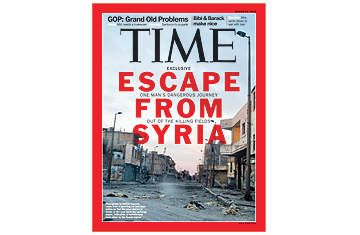
(3 of 6)
The four survivors were ushered into a new hideout: a single room with one small window, surrounded by taller houses and hidden from the street. For the next four days, Daniels, Bouvier, Espinosa and Conroy were trapped there, listening to rockets and shells exploding from 6 a.m. to 6 p.m. and sometimes during the night. "Some days there were 300 bombs," Daniels says. "You cannot imagine what it was like." Noon prayers provided the only daytime lull. It was nearly impossible to communicate with the outside world. In fact, doing so was a huge risk. Phones could help the military pinpoint the journalists' location. And then there was that sound. "A drone overhead," Daniels recalls. "It made us crazy. We could hear it above, all the time, all the time."
With the media center destroyed, the closest Internet connection to the new hideout was a hazardous 10-minute walk through Bab Amr, which was ringed with government snipers. The journalists recorded a video and handed it to activists who braved the route and uploaded it to YouTube. Seen throughout the world, the video showed Daniels, Conroy and Bouvier appealing to French authorities and the International Committee for the Red Cross (ICRC) to evacuate them. Terrified that Assad's forces would find them, they lied about their location, saying in the video that they were far from the hospital. And they appeared curiously upbeat in spite of their injuries. "Edith looked radiant," says Daniels, "because that is her personality and because we were determined to let her family know that her morale was O.K."
Their living conditions, however, were growing worse. The Syrian army had bombed rooftop water tanks, so the taps were running dry. The only light in the evenings came from candles and a gas lamp. Food grew scarce. One day, all the journalists had to eat was a bowl of rice each. The residents of Bab Amr, however, were heartbreakingly kind, offering the visitors candy and cigarettes, at one point even hunting down imported Winstons. They also supplied blankets and an oil heater for the bitterly cold nights. Two activists were assigned to care for Bouvier and Conroy in 12-hour shifts. Most residents of Bab Amr, says Daniels, "had someone in their family, [maybe] several people, who had been killed. We felt very bad saying 'Please help us get out of here. We have lost our friends.' We couldn't say that, because they had lost everything."
A two-hour truce on Friday, Feb. 24, allowed Daniels to shoot photos of the destruction and collect Ochlik's things: a camera so battered it looked like a cauliflower, a computer, a ski cap, a passport--plus a couple of energy bars for the survivors to share. Also in Ochlik's bag was a pocket-size black notebook in which he had written key Arabic-French translations for words including run and escape. Daniels and Espinosa were then driven over to the makeshift morgue in a nearby apartment where Ochlik and Colvin lay. The shrouds had been simply marked in Arabic: WOMAN and MAN. Daniels wrote out their names in block letters, so they could be identified in case the bodies were scattered in the turmoil.
